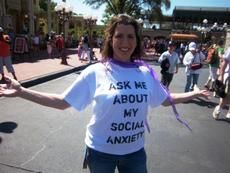
As a psychologist, I am frequently inspired by the resiliency people display in everyday life. Through the Internet and the power of social networking, I have met amazing women whose stories need to be told. Read their success stories and be inspired. I've written full-length posts about each them before. Here I'm sharing their success strategy with a link to their full story.
1. Accept Yourself: Celia
- “You’re doing great work, but you’ve got to come out of your shell.”
- “Have you always been this quiet?”
- "You need to ask yourself, What would Queen Latifah do?"
Celia had heard it all before (well, maybe not the Queen Latifah line). Teachers made her feel that her quiet temperament was a weakness. And she believed it. At least for awhile…
Celia learned that self-acceptance was the first step in overcoming her anxiety. “The more I convinced myself that being quiet is the same as being weird, the more quiet I became,” she said.
She also learned that shyness had its strengths.
“The real revelation for me is that being shy isn’t even necessarily a social handicap. Shy people have a great gift: their gut about whom to trust. It comes from years of observing people and a deep fear of being burned, and it pulls us away from the frigid, hateful and fake.”
"Being shy is, if not a virtue, at least a blessing: it’s a heightened social sense, an intuitive risk aversion that keeps us far from broken bones and broken hearts."
Read Celia’s story: I'm Shy and I'm OK.

2. Join a Support Group: Marla
Marla lived in daily fear. She woke to physical symptoms of anxiety, such as her heart racing, as well as worry about what the day would bring. "Is there a staff meeting where I may be called upon to speak? What should I do about lunch with my coworkers? (She had situational anxietyabout eating in front of others.) Will my boss need to speak with me? Will someone have to observe me as I train them or they train me? What if they invite me to happy hour? And the list went on..."
Marla credits a lot of her own progress in overcoming her social anxiety to joining a support group. She started attending a group in 2006 as a participant, and then became a group facilitator herself.
She also did an unexpected project, especially for someone with social anxiety: She wore a tee-shirt every day while in Disney World that said, "Ask me about my social anxiety."
"I am so passionate about this cause—to raise awareness for social anxiety, to offer hope, to show people they are not alone, and to let them know they don't have to live their lives in fear," she said.
Read more about Marla’s story: Shy Girl, Brave Woman and Joining a Support Group When You're Afraid to Speak.

3. Blog about It: Brittany
Brittany described herself as having debilitating shyness. She dreamed of teaching English abroad, but fear was keeping her from doing this, as well as other things. She started a blog, The Shyness Project, which was a one-year plan she devised to confront her fears. She set a number of goals for herself and held herself accountable by writing publicly about her progress.
“My blog readers definitely helped me keep going. I doubt this project would have been possible without them. I received a lot of really kind emails and comments throughout the project, and that really encouraged me. And when I was told by some of them that I inspired them to confront some of their own anxiety and struggles, I was more determined than ever to keep pushing myself. I really developed a sort of blog family, and they became my support group. They kept me accountable because I didn't want to let them down and I didn't want to let myself down either.”
Read more about Brittany’s story: The Shyness Project and on her website(link is external). (She was also featured on Susan Cain's website, The Power of Introverts(link is external).)

4. Seek Expert Help: Kayla
I first became acquainted with Kayla when I was participating in a documentary on social anxiety disorder called, Afraid of People(link is external). The producer sent me an early "rough cut" of the documentary to watch; I was particularly drawn to the girl with the strawberry-blonde hair. She appeared tormented every time anyone spoke or looked at her. She would gaze downward, her hair falling forward, obscuring her face. She wouldn’t talk to anyone but her family. Kayla had selective mutism.
The key to Kayla’s progress (she’s now a successful college student) was her mother, Sherry, being persistent in getting a diagnosis and specialized treatment. It was not a quick or easy process. They went through numerous doctors before they found Dr. Shipon Blum(link is external), an expert in selective mutism. With Dr. Blum's help, Kayla recovered.
"I will never forget the first time she yelled out the car window to one of her friends after school," Sherry said. "It was as if she finally discovered the voice she never knew she had."
Read more about Kayla’s story: From Quiet to Queen.
You can also read my story: Quiet is Not a Four-Letter Word and Successfully Shy: Things I've Learned.
Oh, and one more thing: Don’t give up. The world needs you and your ideas!



